Abstract
A flight controller formulation based on incremental nonlinear dynamics inversion (INDI) control with nonlinear disturbance observer (NDO) is proposed. INDI control is a nonlinear controller based on incremental dynamics. Aimed to attain robustness for nonlinear dynamics inversion (NDI)-based controller, incremental dynamics are derived using the first-order Talyor series expansion to nonlinear systems. The incremental dynamics-based controller requires information on state derivative terms to strengthen the robustness property of the nonlinear controller. The proposed controller utilizes the first-order low-pass filter to obtain the state derivative estimate to implement incremental dynamics into the system. Because the incremental form creates uncertainty term which is an aftermath of the Taylor series expansion, the proposed controller adopts the NDO to eliminate this effect. The controller is applied to the generic transport model which was developed by NASA for simulation purposes. The proposed NDO-based INDI control underwent simulations, together with an INDI controller without disturbance observer, and showed that the developed method results in better performances, providing important advantages where it compensates the uncertainties, removes the steady-state error, and shows less oscillating longitudinal body rate response than the baseline controller, desirable for aerodynamics applications with faster system response.
1. Introduction
The stable control of a mechanical system is paramount for safe operation. Many control techniques have been studied and researched to ensure the safe operation of diverse mechanical systems, especially aircraft systems. Aircraft control is a challenging task because of aerodynamic uncertainties. The aerodynamics govern the translational and rotational motion of an aircraft where the latter is more difficult to obtain than the former, imposing high uncertainty when implementing a controller. Care has been taken for the safe flight of aircraft using linear and nonlinear controllers which are constantly researched to this day. As an extension, this paper focuses on robust controller formulation for the rotational motion of an aircraft using incremental dynamics and nonlinear disturbance observers. Linear control methodologies, such as traditional proportional–integral–derivative (PID) control [], linear quadratic regulator (LQR) [], and H-Infinity technique [], were introduced and applied to nonlinear systems before research on nonlinear control became mature.
The nonlinear system needs to be transformed into linear counterparts using Taylor series expansion, linearizing the system at each operating point or state to use linear controllers, a method called gain scheduling [,]. The problem with this approach is that as the number of operating states increases, the number of linearized systems also increases, mandating the need to increase the number of tuning processes because of linear controllers for each state. If the control specification is changed, all the linear controllers in every linearized point need to be re-tuned. A few sets of operating states may be used but since a linearized system represents the true nonlinear system only at the close range of state at the linearization, it is recommended to select many sets of linearization points to cover as much region of state space as possible to match the nonlinear system being controlled.
Nonlinear control methodologies like feedback linearization-based nonlinear dynamic inversion (NDI) control [] and backstepping [], which have been developed and improved, have relieved the burden of gain scheduling required for linear controllers. To do so, nonlinear controllers, such as those based on diffeomorphic mapping functions, eliminate the need for gain scheduling by transforming systems into linear equivalents [,]. The nonlinear controllers are especially useful to conventional fixed-wing aircrafts which eliminate the need for gain scheduling.
Lee, Jun, and Lee [] showed that nonlinear controllers using diffeomorphic mapping are equivalent to linear controllers derived from linearized state transition systems using Taylor series expansion. This relationship indicates that nonlinear controllers could provide more cost-effective solutions compared to linear controllers, which explains their widespread use in military aircraft applications []. However, the reliability of the linear systems derived from diffeomorphic mapping heavily depends on the accuracy of the nonlinear system model []. If the uncertainties in the diffeomorphic mapping function increase from the true model, the performance of the nonlinear controllers may decrease and even fall into instability due to incorrect mapping. This poses a serious problem for the rotational flight control of aircraft as rotational aerodynamics are hard to acquire accurately.
Incremental dynamics is a modification of nonlinear dynamics that is derived from the Taylor series expansion. The idea of incremental dynamics originated from Smith’s research [] and was later improved upon by Bacon []. Proposed to mitigate model dependency, the incremental dynamics involves directly using the state derivative. The nonlinear mapping function based on the incremental dynamics can be used to obtain linear dynamics where linear control methods can be used. This incremental nonlinear dynamics inversion (INDI) control demonstrates robust characteristics due to less model dependency []. Controllers based on incremental dynamics demonstrate robust characteristics in this context. The incremental dynamics-based controller suppresses the disturbances better at higher update frequency []. Other requirements for this controller are that the control input should affect the system much higher than the system dynamics and the control effectiveness matrix must be exact [].
The state derivative information required for incremental dynamics-based controllers poses a problem when it is not measured by onboard sensors, particularly in our case to control rotational motion. The common control state variable for aircraft systems is body rate which can be measured by gyroscopic sensors. The derivative of body rate is not provided in most aircraft systems, as sensors measuring angular acceleration are not widely manufactured nor easily procured compared to cheap and abundant gyroscopic sensors. This indicates that to apply incremental dynamics-based controllers to the rotational control of an aircraft, state derivative must be estimated.
The simplest method for calculating derivative terms is numerical differentiation. However, this approach amplifies noise as the sample time decreases, reducing accuracy. Alternatively, first- or second-order low-pass filters can be used, as discussed by Smeur, Chu, and Croon [] and Steffensen, Steinert, and Holzapfel [], who combined this with incremental dynamics-based controllers and gain scheduling. In this research, a first-order low-pass filter is used to obtain the derivative of the body rate. This process requires uncertainty estimation for it to work properly.
To address above mentioned concerns, a disturbance observer-based uncertainty estimation is proposed in various related works. The high-order sliding mode disturbance observer (HOSMDO) was proposed in [] without measuring state derivative terms but requires upper bounds of uncertainties and has an inherent chattering problem. The time delay adaptation method was proposed in [] but requires system model information. Ignatyev et al., in [], proposed a Gaussian process regression-based data-driven adaptive controller but the method requires high computational power and state derivative term. Nonlinear disturbance observer (NDO) is proposed by Chen et al. [] to estimate disturbances and uncertainties in the given nonlinear system. The NDO does not require knowledge of state derivatives to estimate the disturbances. The assumption for the NDO to work properly is that the disturbance should be constant or slowly varying.
Among different types of uncertainty estimation, the proposed controller utilized NDO. The incremental dynamics-based controller assumes the system model term as uncertainty, as it affects the state derivative relatively smaller and slower compared to the control model part. This forms the valid assumption for the NDO to work properly. The NDO is also a model-based algorithm but to use NDO in more practical situations, the aerodynamics coefficient required for the NDO was assumed not known except for the direction of the aileron, elevator, and rudder actuator control surfaces. For further uncertainty quantification, investigation approaches as in [,] can also be considered based on the analysis methodology in this research.
The motivation for the proposed research stems from the challenges associated with controlling the rotational motion of aircraft due to the uncertainties in aerodynamics, which complicate the implementation of traditional control methods. The necessity arises because the existing linear control approaches, like gain scheduling, demand extensive tuning and struggle to accurately represent nonlinear behaviors across a wide range of operating conditions. Meanwhile, nonlinear controllers, while promising, still face limitations when there are uncertainties in the system model. The proposed research addresses these issues by integrating incremental dynamics and an NDO, which reduces model dependency and enhances robustness by estimating disturbances without requiring direct state derivative measurements. The advantages of this approach include improved control performance in the presence of uncertainties, reduced reliance on detailed aerodynamic models, and practical applicability to aircraft systems where state derivative information is often unavailable.
The contribution of the proposed controller based on INDI and NDO are as follows: The proposed method uses an incremental dynamics-based nonlinear controller to attain robust properties. Second, the controller implements NDO to estimate uncertainties arising from incremental dynamics for compensation. Moreover, the NDO assumes no prior model information except the control direction of actuators. The simulation result shows the performance increase in the proposed method compared to INDI without NDO. The flight controller is tested on the generic transport model (GTM) developed by NASA in the simulation.
The remaining sections of this paper are organized as follows: Section 2 defines the problem statement. Section 3 provides the equation of motion of an aircraft. The proposed control method is explained in detail in Section 4. Section 5 describes stability analysis issues, and Section 6 shows the simulation results. Finally, Section 7 presents the conclusions.
2. Problem Statement
The following state derivative equation that represents an ordinary aircraft system is presented:
where , , , and .
The true system above is composed of a predicted system and uncertainty term which can be written as follows:
where is for the predicted system and is the uncertainty in the system. The input state and are dropped for brevity.
The objective of this research is to design a controller that calculates the control input that makes the state given the above state derivative equation. The system and state of interest are the aircraft system and body rate of the aircraft motion which will be explained later.
3. Equation of Motion
The motion of the aircraft system is expressed as 6 degrees of freedom. The state derivative equation of the aircraft can be derived using Newton’s law of motion and the following equation is attained:
where
In the above equation, , , and are the distances of the center of gravity (CG) location from the aircraft reference system (ARS) frame; is the body rate vector along the ARS frame; is the body velocity vector of ARS frame; is the moment of inertia matrix of the aircraft; and is the identity matrix of order N. The ARS frame is the reference body frame to which sensors are attached. Normally, it is chosen as close to the CG as possible. Figure 1 shows the inertial frame , ARS frame , and CG point . The detailed derivation of the above equations can be found in [,,,], and is described in Appendix A.
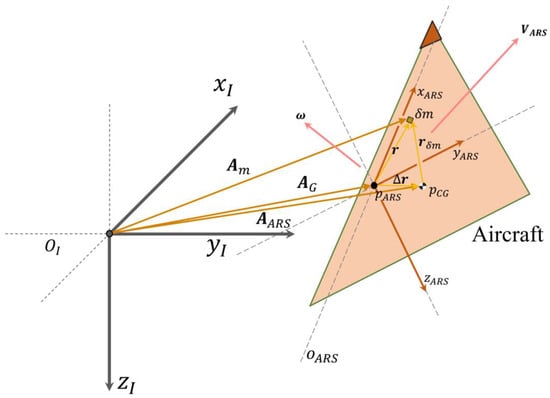
Figure 1.
Inertial frame, aircraft reference frame, CG point, and corresponding , , and basis vectors.
The and are the external forces and moments, respectively, acting on the CG and they are
where is a dynamic pressure with density ρ and total speed ; is the wing area; and are the wing span and chord length; and are the translational aerodynamic coefficients; and are the trim rotational aerodynamic coefficients; and are the actuator rotational aerodynamic coefficients; α is the angle of attack; are the body rates along the ARS axes; and are the aileron, elevator, and rudder actuator deflection. The detailed derivation of the above equations can be found in [].
4. Proposed Control Method
The proposed controller augments incremental dynamic inversion (INDI) control and NDO.
4.1. Incremental Dynamics
The derivation of incremental dynamics is relatively simple. Applying Taylor series expansion to the state derivative Equation (2),
where with previous time step value denoted by subscript 0, means higher order terms and is the sum of the remaining uncertainty terms.
4.2. Nonlinear Disturbance Observer
The nonlinear disturbance observer proposed by Chen et al. [] is implemented to estimate disturbance. Assuming that the disturbance in Equation (1) is slowly varying or constant, the time derivative of the disturbance can be expressed as follows:
Then, the observer error can be defined as follows:
where the represents the disturbance estimates. The desired disturbance error dynamics is chosen as the 1st-order system.
where L (the observer gain) is chosen as the Hurwitz matrix.
The observer error pursues the above desired disturbance error dynamics if the following disturbance observer dynamics relationship holds
where is a function of state x and control input u, already including the model dynamics and control input terms. Defining an auxiliary variable as follows:
Then, the observer error dynamics by solving the differential equation of Equation (9) will become the following:
The observer error will eventually converge to 0, exponentially. Here, the above solution of Equation (14) is derived from Equation (9) using the nonlinear dynamic observer in detail as explained in Appendix B.
4.3. Incremental Nonlinear Dynamics Inversion Control with Nonlinear Disturbance Observer
The proposed controller combines incremental nonlinear dynamic inversion and nonlinear disturbance observer. The INDI-NDO control input can be selected as follows:
where is the pseudo control input. Then, Equation (6) becomes
The state derivative has to be estimated to apply the control input in Equation (15). The estimated state derivative is using the first-order low-pass filter as follows:
The is estimated using Equations (11)–(13). Selecting the system dynamics as follows:
we then transform Equation (13) to
After integrating the above equation, can be calculated as follows:
The control and measured variables are , meaning the NDO input is selected as . Hence, the disturbance is observable, since the control and measured variables are identical, as in
where is the measurement of , the observation matrix is an identity matrix , and (random variable vector) has a normal distribution with zero mean vector and variance .
4.4. Control Objective
The body rate vector in Equation (3) of an aircraft is treated as the control variable. Therefore, the control objective is to create a control input in Equation (5) such that where is our reference command. Figure 2 shows the block diagram of the proposed controller law. The baseline controller is an incremental nonlinear dynamic inversion controller with the first-order low-pass filter as our state derivative estimator and NDO for our uncertainty estimation.
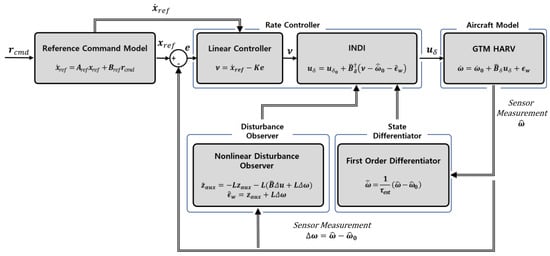
Figure 2.
Block diagram of incremental dynamic based on the rotational flight controller with nonlinear disturbance observer.
Equation (3) can be expressed in incremental form as in (6),
where is the a priori control allocation matrix and is the uncertainty term. The detailed derivation can also be found in []. Consequently, the control input (15) becomes
where is the pseudo control input. Applying the above control input to Equation (22), the state derivative Equation (16) is expressed as follows:
where is the true and estimated uncertainty.
5. Stability Analysis
The stability proof is based on the general state derivative form in Equation (6) and control input in Equation (15). For stability proof, the following assumptions are defined:
Assumption 1.
The error between the state derivative estimate using a low-pass filter in Equation (17) and the true state derivative is bounded such as .
Assumption 2.
The nonlinear disturbance observer estimate error designed using Equations (10)–(13) converges exponentially as in Equation (14).
Let us define an error dynamics as follows:
Then
where which is chosen as the Hurwitz matrix and . Selecting the Lyapunov function as follows:
where is a positive definite matrix obtained from solving the Lyapunov equation []. The time derivative of the above Lyapunov equation becomes
Then, from [] (Chapter 4, Theorem 4.18), the solution of the above equation satisfies
where is a class KL function, is an initial time, is a time constant, and and are the class K functions. The definition of the class KL and K functions can be found in [], Chapter 4. This completes the stability proof.
6. Simulation Results
The GTM is a scaled-down, 5.5% model of a commercial twin-engine aircraft developed by NASA, serving as a vital research tool for studying aircraft dynamics under adverse flight conditions, such as structural damage. It acts as a testbed to examine how damage affects the aerodynamics, stability, and inertial properties of the aircraft, including changes in aerodynamic forces, stability derivatives, and the center of gravity. The GTM is utilized in wind tunnel tests, numerical simulations, and computational modeling to investigate how different damage scenarios, like wing separation, influence flight dynamics, such as reductions in lift and pitch moment variations, and coupling effects between longitudinal and lateral motions. These insights are crucial for developing adaptive flight control strategies that can compensate for the altered dynamics and maintain aircraft stability. By supporting the creation of resilient control systems, the GTM aligns with the objectives of NASA’s Aviation Safety Program, which aims to enhance aircraft survivability and safety in emergency situations involving structural damage. The GTM aerodynamic modeling used for the simulation can be found in the reference by Ouellette et al. [].
The simulation of the GTM is processed by applying the proposed INDI controller that estimates model uncertainties with the NDO and without the NDO. The control allocation matrix used for the simulation is
implying that the controller only knows the control direction or sign.
Figure 3 shows the total velocity , angle of attack , and side slip angle responses of the baseline controller and proposed controller. The responses of both controllers are within 47.4 and 50.5 m/s and follow a similar trend, indicating that the dynamic pressures of the aircraft under both controllers are comparable. The responses of the two systems also exhibit similar behaviors. However, the response with the INDI-NDO shows a more dramatic response.
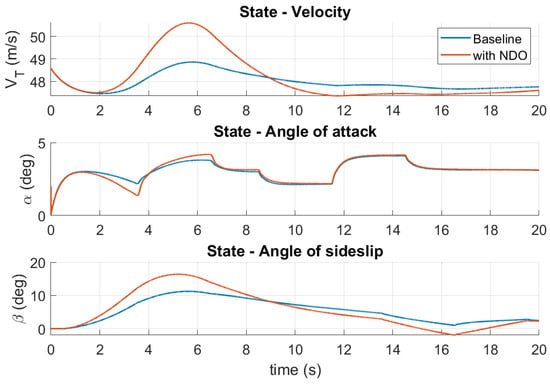
Figure 3.
, , and responses of the proposed INDI with the NDO and without the NDO.
The following Figure 4, Figure 5 and Figure 6 demonstrate the , , and responses to the , , and results of our proposed controller and ordinary INDI. Figure 2 and Figure 4 clearly demonstrate that the INDI-NDO method reduces steady-state error compared to the proposed INDI with NDO, particularly in the and , while Figure 5 shows a reduction in oscillation in response.
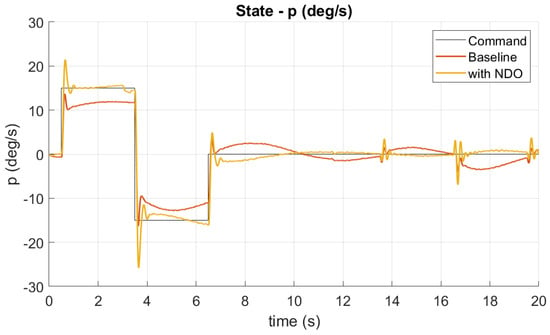
Figure 4.
Roll rate responses of the proposed INDI with the NDO and without the NDO.
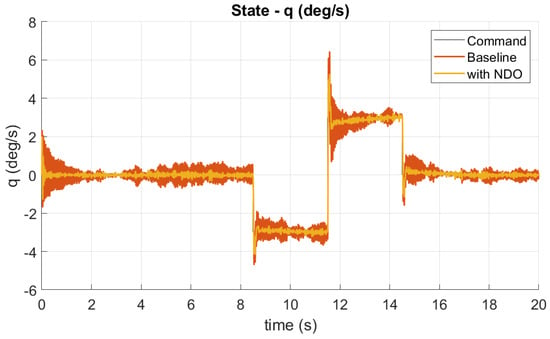
Figure 5.
Pitch rate responses of the proposed INDI with the NDO and without the NDO.

Figure 6.
Yaw rate responses of the proposed INDI with the NDO and without the NDO.
The responses in Figure 3 of the proposed and baseline controllers can be explained by the and responses as all of them are related to the lateral motion of the aircraft. The ordinary controller has an inaccurate control allocation matrix as in Equation (32) and leads to wrong control input calculation prompting steady-state error and performance deterioration. The aileron and rudder input based on Equation (32) controlling lateral motion and was not enough, resulting in the steady-state error exhibited in Figure 4 and Figure 6, and also resulting in subtle movement in . The INDI-NDO overcame this issue and exerted more aggressive control, removing the steady-state error in and , resulting in more substantial movement in .
The ideal state estimation and disturbance in Equation (24) leads to . The response of error is generated as in the following Figure 7, Figure 8 and Figure 9. The and on the lateral motion response in Figure 7 and Figure 9 shows more error during maneuver created by and that the INDI-NDI control input is more aggressive compared to the baseline controller, but converges to zero indicating that the uncertainty error in Equation (24) converges to zero. The error on the longitudinal motion also shows that the proposed controller produces less oscillation, controlling the with a more subtle response than that of the baseline controller.
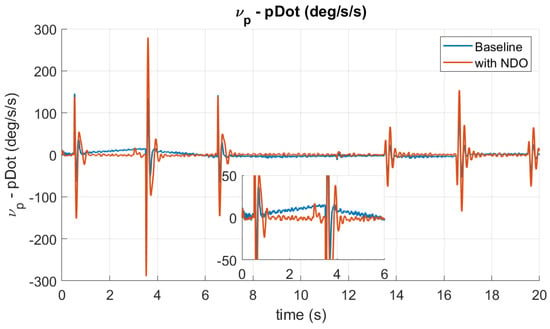
Figure 7.
Responses of the error between the roll pseudo control input and roll angular acceleration of the proposed INDI with the NDO and without the NDO.

Figure 8.
Responses of the error between the pitch pseudo control input and pitch angular acceleration of the proposed INDI with the NDO and without the NDO.
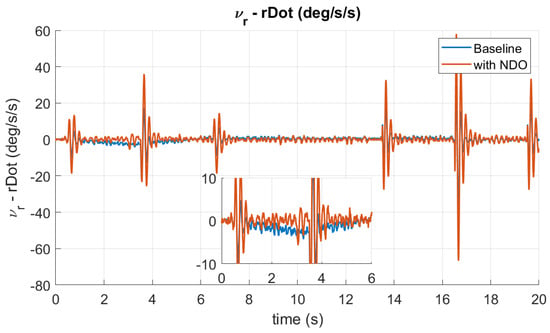
Figure 9.
Responses of the error between the yaw pseudo control input and yaw angular acceleration of the proposed INDI with the NDO and without the NDO.
7. Conclusions
An INDI-NDO controller is proposed to compensate for model uncertainty. As incremental dynamics contains uncertainty from the Taylor series expansion during the derivation process and requires state derivative estimate, the NDO is implemented to the INDI controller for the estimation of these uncertainties. The theoretical guarantee of the proposed controller is also addressed in this paper. For the simulation environment, the GTM is used for the performance comparison of the proposed controller and the ordinary baseline controller. A simple control allocation matrix that only knows the control direction of the actuators is implemented. The proposed controller provides the advantages of compensating the uncertainties and removing the steady-state error, which the baseline controller could not achieve. Also, the proposed controller shows less oscillating longitudinal body rate response than the baseline controller. The controller with the NDO shows the elimination of steady-state error and a faster response compared to the INDI controller without the NDO.
Author Contributions
Conceptualization, L.K.; methodology, L.K.; software, L.K.; formal analysis, L.K.; writing—original draft preparation, L.K.; writing—review and editing, J.I.K.; project administration, J.I.K. All authors have read and agreed to the published version of the manuscript.
Funding
This research received no external funding.
Institutional Review Board Statement
Not applicable.
Informed Consent Statement
Not applicable.
Data Availability Statement
The data presented in this study are available on request from the corresponding author. The data are not publicly available due to privacy.
Acknowledgments
The authors would like to acknowledge the support of a grant by the CNU study program (2022 and 2023) of Chungnam National University.
Conflicts of Interest
The authors declare no conflicts of interest.
Appendix A
The derivation of Equation (3) is presented. Referring to Figure 1, the relative distance from to elemental mass is
where is an offset vector from to the shifted CG point . Using Newton’s law of motion, the external force in the inertial frame is equal to adding all the linear momentum of as in
where is the body linear velocity in , and is the body rate also in . Both vector sums undergo a time derivative in the inertial frame . Simplifying, we obtain the following:
The subscript denotes that the derivative is taken in the frame and is the total mass. Applying the transport theorem and neglecting the term from the time rate of change in CG location,
where and . In addition, denotes the time derivative in the frame .
The angular momentum equation is derived in a similar manner. The angular momentum HB at the point is given such that
where is a velocity of differential mass . Then, the equation becomes
where is the moment of the inertia matrix. The time derivative of the angular momentum in frame becomes
where the external moment on the inertial frame is by definition. Since and , they become
Finally, the moment equation is obtained as
The derived force and moment equations can be organized as in Equations (3) and (4).
Appendix B
The derivation of Equation (9) is presented. Differentiating Equation (8) and applying Equation (7), the time derivative of Equation (11), and Equation (13),
The above disturbance error dynamics has the first-order differential equation form as that of Equation (9), eventually having a solution of Equation (14).
References
- Nelson, R.C. Flight Stability and Automatic Control; WCB, McGraw Hill: New York, NJ, USA, 1998; Volume 2. [Google Scholar]
- Chrif, L.; Kadda, Z.M. Aircraft control system using LQG and LQR controller with optimal estimation-Kalman filter design. Proc. Eng. 2014, 80, 245–257. [Google Scholar] [CrossRef]
- Gadewadikar, J.; Lewis, F. Aircraft flight controller tracking design using h-infinity static output-feedback. Trans. Inst. Meas. Control 2006, 28, 429–440. [Google Scholar] [CrossRef]
- Balas, G.J. Flight control law design: An industry perspective. Eur. J. Control 2003, 9, 207–226. [Google Scholar] [CrossRef]
- Prasad, B.; Pradeep, S. Automatic landing system design using feedback linearization method. In Proceedings of the AIAA Infotech@Aerospace 2007 Conference and Exhibit, Rohnert Park, CA, USA, 7–10 May 2007; p. 2773. [Google Scholar]
- Härkegård, O. Backstepping and Control Allocation with Applications to Flight Control. Ph.D. Thesis, Linköpings Universitet, Linköping, Sweden, 2003. [Google Scholar]
- Slotine, J.J.E. Applied Nonlinear Control; Prentice Hall: Upper Saddle River, NJ, USA, 1991; Volume 199. [Google Scholar]
- Lu, Q.; Sun, Y.; Mei, S. Nonlinear Control Systems and Power System Dynamics; Kluwer Academic Publishers: Norwell, MA, USA, 2001; Volume 10. [Google Scholar]
- Lee, C.H.; Jun, B.E.; Lee, J.I. Connections between linear and nonlinear missile autopilots via three-loop topology. J. Guid. Control Dyn. 2016, 39, 1426–1432. [Google Scholar] [CrossRef]
- Balas, G.; Hodgkinson, J. Control design methods for good flying qualities. In Proceedings of the AIAA Atmospheric Flight Mechanics Conference, Chicago, IL, USA, 10–13 August 2009; p. 6319. [Google Scholar]
- van’t Veld, R. Incremental Nonlinear Dynamic Inversion Flight Control: Stability and Robustness Analysis and Improvements. Master’s Thesis, TU Delft, Delft, The Netherlands, 2016. [Google Scholar]
- Smith, P. A simplified approach to nonlinear dynamic inversion based flight control. In Proceedings of the 23rd Atmospheric Flight Mechanics Conference, Boston, MA, USA, 10–12 August 1998; p. 4461. [Google Scholar]
- Bacon, B.J.; Ostroff, A.J.; Joshi, S.M. Reconfigurable NDI controller using inertial sensor failure detection & isolation. IEEE Trans. Aerosp. Electron. Syst. 2001, 37, 1373–1383. [Google Scholar]
- Ronald, V.; Kampen, E.J.V.; Chu, Q.P. Stability and robustness analysis and improvements for incremental nonlinear dynamic inversion control. In Proceedings of the 2018 AIAA Guidance, Navigation, and Control Conference, Kissimmee, FL, USA, 8–12 January 2018; p. 1127. [Google Scholar]
- Smeur, E.J.; Chu, Q.; Croon, G.C. Adaptive incremental nonlinear dynamic inversion for attitude control of micro air vehicles. J. Guid. Control Dyn. 2016, 39, 450–461. [Google Scholar] [CrossRef]
- Steffensen, R.; Steinert, A.; Holzapfel, F. Incremental control as an enhanced and robust implementation of gain scheduled controllers avoiding hidden coupling terms. Aerosp. Sci. Technol. 2023, 141, 108500. [Google Scholar] [CrossRef]
- Shtessel, Y.; Edwards, C.; Fridman, L.; Levant, A. Sliding Mode Control and Observation; Springer: New York, NY, USA, 2014; Volume 10. [Google Scholar]
- Lee, C.H.; Kim, T.H.; Tahk, M.J. Agile missile autopilot design using nonlinear backstepping control with time-delay adaptation. Trans. Jpn. Soc. Aeronaut. Space Sci. 2014, 57, 9–20. [Google Scholar]
- Ignatyev, D.; Shin, H.S.; Tsourdos, A. Gaussian process adaptive incremental backstepping flight control. In Proceedings of the AIAA SCITECH 2022 Forum, San Diego, CA, USA, 3–7 January 2022; p. 2032. [Google Scholar]
- Chen, W.H.; Ostroff, A.J.; Joshi, S.M. A nonlinear disturbance observer for robotic manipulators. IEEE Trans. Ind. Electron. 2000, 47, 932–938. [Google Scholar] [CrossRef]
- Zhao, H.; Zhang, Y.; Zhu, W.; Fu, C.; Lu, K. A comprehensive study on seismic dynamic responses of stochastic structures using sparse grid-based polynomial chaos expansion. Eng. Struct. 2024, 306, 117753. [Google Scholar] [CrossRef]
- Zhao, H.; Fu, C.; Zhang, Y.; Zhu, W.; Lu, K.; Francis, E.M. Dimensional decomposition-aided metamodels for uncertainty quantification and optimization in engineering: A review. Comput. Methods Appl. Mech. Eng. 2024, 428, 117098. [Google Scholar] [CrossRef]
- Bacon, B.; Gregory, I. General equations of motion for a damaged asymmetric aircraft. In Proceedings of the AIAA Atmospheric Flight Mechanics Conference and Exhibit, Hilton Head, SC, USA, 20–23 August 2007; p. 6306. [Google Scholar]
- Kim, L.; Lee, J.D.; Zewege, N.S.; Bang, H. Gaussian process-based state derivative estimator with temporal input in incremental flight control design. Aerosp. Sci. Technol. 2024, 148, 109070. [Google Scholar] [CrossRef]
- Nguyen, N.; Krishnakumar, K.; Kaneshige, J.; Nespeca, P. Flight dynamics and hybrid adaptive control of damaged aircraft. J. Guid. Control Dyn. 2008, 31, 751–764. [Google Scholar] [CrossRef]
- Yan, B.; Li, Y.; Dai, P.; Liu, S. Aerodynamic analysis, dynamic modeling, and control of a morphing aircraft. J. Aerosp. Eng. 2019, 32, 04019058. [Google Scholar] [CrossRef]
- Khalil, H.K. Nonlinear Systems, 3rd ed.; Prentice Hall: Upper Saddle River, NJ, USA, 2002. [Google Scholar]
- Ouellette, J.; Raghavan, B.; Patil, M.; Kapania, R. Flight dynamics and structural load distribution for a damaged aircraft. In Proceedings of the AIAA Atmospheric Flight Mechanics Conference, Chicago, IL, USA, 10–13 August 2009; p. 6153. [Google Scholar]
Disclaimer/Publisher’s Note: The statements, opinions and data contained in all publications are solely those of the individual author(s) and contributor(s) and not of MDPI and/or the editor(s). MDPI and/or the editor(s) disclaim responsibility for any injury to people or property resulting from any ideas, methods, instructions or products referred to in the content. |
© 2024 by the authors. Licensee MDPI, Basel, Switzerland. This article is an open access article distributed under the terms and conditions of the Creative Commons Attribution (CC BY) license (https://creativecommons.org/licenses/by/4.0/).